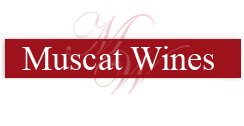MUSCAT WINES OF FRANCE
Muscat Blanc a Petits Grains is the grape responsible for most of France’s distinguished vin doux naturels. The wines display the classic attributes of this grape.
(In the 2010 Muscats du Monde wine competition, France has five Muscat wines listed in the Top 10 Best Muscats for 2010:
• Muscat de Lunel-Cuvee Prestige (Les Vignerons de Muscat de Lunel)
• Muscat de Rivesaltes Gerard Bertrand 2009 (Gerard Bertrand)
• Vin De Pays de l’Ile de Beaute Cantabile Nectar ( Scea du Domaine Casablanca)
• Vin d’Alsace :Terroir: Muscat-Lieu dit Schieferberg 2009 ( Domaine du Moulin de Dusenbach)
• Alsace Grand Cru Muscat Goldert “Vendanges Tradives”-Clos Saint Imer 2005 (Domaine Ernest Burn)
Clairette de Die
A sparkling white appellation centered on the town of Die which is located on the Drome tributary in the eastern Rhone region of France. It is made from varying blends of Muscat Blanc a Petits Grains and the Clairette grape producing a sparkling white wine with a fruity, musky taste. (Some still Clairette de Die is also produced.)
Clairette de Die Tradition (Sparkling wine)
A fizzy wine made by the “methode dioise” (after pressing, the grape juice is filtered and kept at below zero temperatures before being fermented. The wine is bottled and a second fermentation occurs in the bottle. The wine is decanted off and bottled again under pressure resulting in a fizzy wine with an alcoholic strength of 7%-8%).
Muscat d’Alsace
Muscat d’Alsace, a synonym for Muscat Blanc a Petits Grains, is the oldest Muscat grown in Alsace. Muscat Ottonel is of more recent origin (said to have been developed in Loire). Most Alsatian Muscat is a blend of both of these grapes. What distinguishes this Muscat from other French Muscats is that it is usually produced as a dry table wine. The wine is characterized by a fruity aroma, and a light fresh body that makes it an excellent aperitif (Producers say it is a perfect match for asparagus.)
Muscat de Beaumes-de-Venise
The Village of Beaumes de Venise is home to this outstanding Muscat wine which is considered to be the best of the South of France’s several vins doux naturels (fortified sweet wines).This wine displays very delicate, lovely aromas and flavours and can reach an alcohol strength of 21%. . Although it is only made from Muscat Blanc a Petits Grains, the Muscat grown in the region has two sub-varieties-the Grain Blanc and the Grain Noir. The appealing golden hue of this wine is created by a combination of these two colors. These Vin Doux Naturels wines must receive an official certificate before they can be marketed.
Domaine de Fenouillet
Muscat de Beaumes de Venise 2018
Made with Muscat Blanc à Petits Grains and Muscat Rouge à Petits Grains.
Muscat du Cap Corse
This rare wine is produced from Muscat Blanc a Petits Grains in the northern part of the island of Corsica. The grapes are picked late (October) when they have developed a large amount of residual sugars. The grapes are pressed and fermented but pure alcohol is added during the fermentation process. This raises the alcohol level to around 15%, and leaves a lot of sugars in the wine creating a sweet wine with very intense fruit and flower flavors. This is a recent AOC (1993?,1996?) although the production of Muscat de Corse dates from a long time ago.
M
Muscat de Frontignan, or Vin de Frontignan or Frontignan
This wine is considered to be the most important of Languedoc’s four Muscats. Frontignan was famous for its Muscats for centuries and is the first vin doux naturel appellation to be officially recognized. As with all the other Languedoc Muscats (Lunel, Mireval and St. Jean de Minervois) only Muscat Blanc de Petits Grains can be used and the final wine must be at least 15% alcohol. Some of the wine is made as a vin de liqueur (addition of alcohol to unfermented must). It is a luxury wine with a beautiful golden colour and a distinctive aroma.
Muscat de Lunel
One of Languedoc’s vin doux naturel Muscats. Lunel is the town in southern France that is the center for the Muscat de Lunel appellation. The vines are grown on challenging soils between Montpellier and Nimes. The silica-based soil gives this wine a fine, highly distinguished character while retaining its subtle, delicate bouquet.
Muscat de Mireval
One of Languedoc’s vin doux naturel Muscats. Mireval is a large village that the appellation is named after. Made entirely from around 640 acres of Muscat Blanc a Petits Grains grapes, the wine is very much like Muscat de Frontignan which is produced to the west of Mireval. The wine is sweet, fruity, and well balanced.
Muscat de Rivesaltes
The appellation covers wine made from vines grown in Rivesaltes (a town north of Perpignan in Roussillon’s wine producing area in Southern France), Maury or Banyuls. Muscat de Rivesaltes represents about 70% of France’s total Muscat production. Two types of Muscat are allowed: Muscat Blanc a Petits Grains and Muscat d’Alexandrie. The grapes are made into wine either by direct pressing or by maceration. This aromatic wine is the Queen of Muscats with a long lingering finish. Its distinctive characteristics are due to the dry Roussillon soils, to the hot southern sun and to the blending of the two Muscat varieties. Drink young and as cool as possible.
Muscat de St-Jean-de-Minevois
One of Languedoc’s vin doux naturel Muscats. Produced in the extreme northeast of Languedoc. One of France’s rarest wines. This appellation produces some of the finest Muscat wines of the Mediterranean. Their bouquet is full and compelling, and they make for excellent dessert wines.
